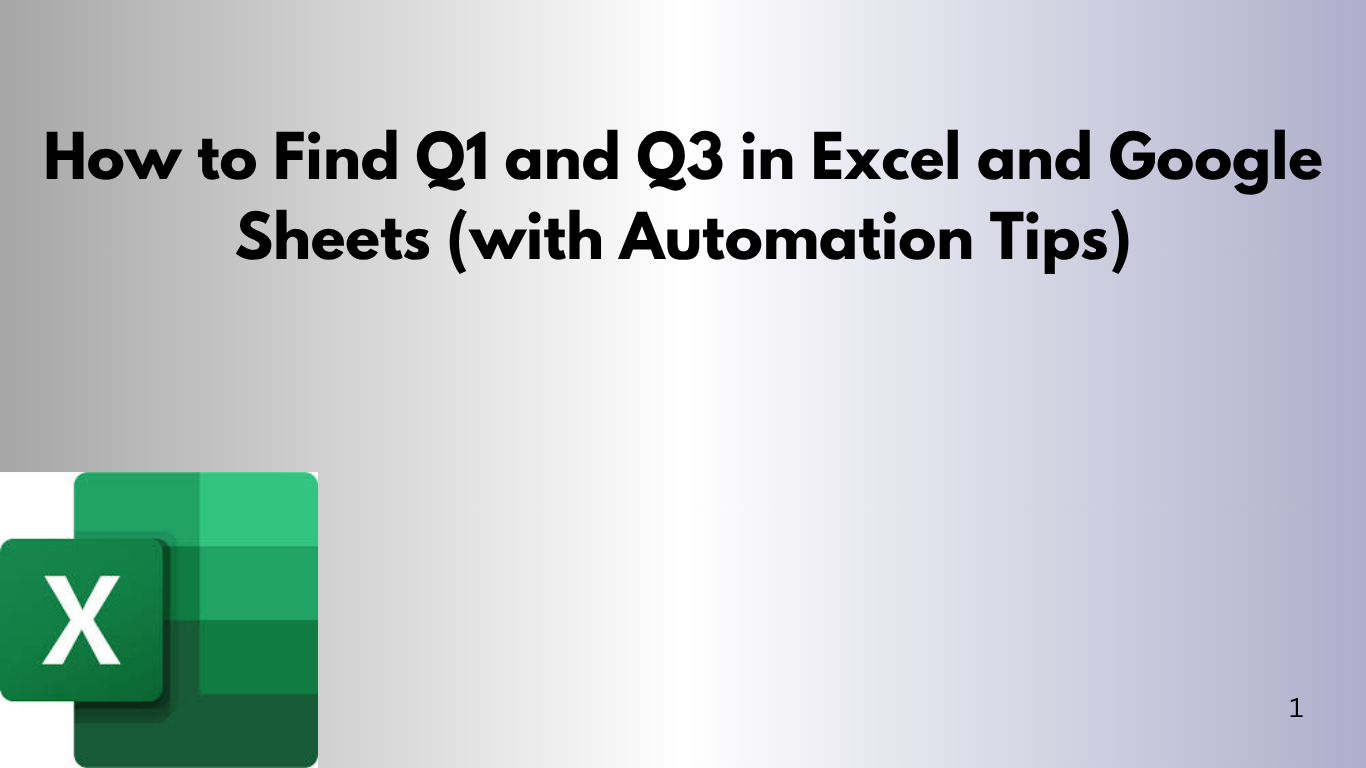When you're diving into data analysis, understanding the spread of your data is super important. Two key statistics that help with this are the first quartile (Q1) and third quartile (Q3). These numbers give you insights into how your data is distributed and can help you spot trends or outliers.
In this blog post, I'll show you how to calculate Q1 and Q3 in both Excel and Google Sheets, and even how to automate the process so you don’t have to keep doing the same calculations over and over again.
What Exactly Are Q1 and Q3?
- Q1 (First Quartile): This is the value below which 25% of your data falls. Think of it as the "median" of the lower half of your data.
- Q3 (Third Quartile): This is the value below which 75% of your data falls. It’s the "median" of the upper half.
Q1 and Q3, along with the median (Q2), make up the interquartile range (IQR), which shows you how spread out your data is.
How to Find Q1 and Q3 in Excel
Option 1: Using the QUARTILE Function
In Excel, you can quickly find Q1 and Q3 using the QUARTILE or QUARTILE.INC function.
Steps:
- Pick a cell where you want to display Q1 (let's say B1).
- Type in the formula to find Q1:
=QUARTILE.INC(A2:A100, 1)
Here,
A2:A100is the range of your data, and1is for the first quartile. - Pick another cell for Q3 (let's say B2).
- To calculate Q3, use this formula:
=QUARTILE.INC(A2:A100, 3)
Option 2: Using PERCENTILE Function
If you prefer, you can use the PERCENTILE.INC function, which works similarly to the QUARTILE function.
Steps:
- For Q1, type in:
=PERCENTILE.INC(A2:A100, 0.25)
- For Q3, type in:
=PERCENTILE.INC(A2:A100, 0.75)
Both options will give you the same result, so feel free to use whichever one you find easier!
Automating Q1 and Q3 in Excel
If you find yourself calculating Q1 and Q3 often, you can automate the process to save time.
How to Automate Using VBA (Excel Macros)
Excel allows you to write simple macros using VBA (Visual Basic for Applications), which can help you automate repetitive tasks. Here’s how you can create a macro to calculate Q1 and Q3.
- Press Alt + F11 to open the VBA editor.
- Go to Insert > Module and paste this code:
Sub CalculateQuartiles() Dim dataRange As Range Set dataRange = Range("A2:A100") ' Adjust your data range here ' Calculate Q1 Range("B1").Value = WorksheetFunction.Quartile_Inc(dataRange, 1) ' Calculate Q3 Range("B2").Value = WorksheetFunction.Quartile_Inc(dataRange, 3) End Sub - After you’ve pasted the code, press Ctrl + S to save and close the VBA editor.
- To run the macro, press Alt + F8, select
CalculateQuartiles, and hit Run.
This will instantly calculate Q1 and Q3 for you and put the results in cells B1 and B2.
How to Find Q1 and Q3 in Google Sheets
In Google Sheets, the process is similar to Excel. Here’s how to do it:
Option 1: Using the QUARTILE Function
Google Sheets has a QUARTILE function, just like Excel.
Steps:
- To find Q1, type this formula in a cell (e.g., B1):
=QUARTILE(A2:A100, 1)
- To find Q3, type this formula in another cell (e.g., B2):
=QUARTILE(A2:A100, 3)
Option 2: Using the PERCENTILE Function
If you prefer, you can use the PERCENTILE function instead.
Steps:
- For Q1, enter:
=PERCENTILE(A2:A100, 0.25)
- For Q3, enter:
=PERCENTILE(A2:A100, 0.75)
Automating Q1 and Q3 in Google Sheets
Google Sheets doesn’t use VBA like Excel, but you can still automate your quartile calculations with Google Apps Script.
Automating with Google Apps Script
Follow these steps to set up your automation:
- Open your Google Sheets document.
- Go to Extensions > Apps Script.
- In the script editor, paste this code:
function calculateQuartiles() { var sheet = SpreadsheetApp.getActiveSpreadsheet().getActiveSheet(); var dataRange = sheet.getRange("A2:A100"); // Adjust as needed var data = dataRange.getValues(); var q1 = percentile(data, 0.25); var q3 = percentile(data, 0.75); sheet.getRange("B1").setValue(q1); sheet.getRange("B2").setValue(q3); } function percentile(data, p) { data = data.filter(String); // Remove empty values data.sort(function(a, b) { return a - b }); var index = (data.length - 1) * p; var lower = Math.floor(index); var upper = Math.ceil(index); if (lower === upper) { return data[lower]; } return data[lower] * (upper - index) + data[upper] * (index - lower); } - Save the script, then go back to your sheet.
- Go to Extensions > Macros > Import and select
calculateQuartiles. - Now, you can run the
calculateQuartilesfunction from the Macros menu, and it will automatically calculate and fill in Q1 and Q3 in cells B1 and B2.
Wrapping Up
Whether you're using Excel or Google Sheets, finding Q1 and Q3 is a quick way to understand how your data is spread out. With the built-in QUARTILE and PERCENTILE functions, it's easy to get the values you need. And if you're working with large datasets or repeating calculations, automating the process with VBA in Excel or Google Apps Script in Sheets can save you a ton of time.
So next time you need to calculate quartiles, you’ve got everything you need to do it efficiently!
